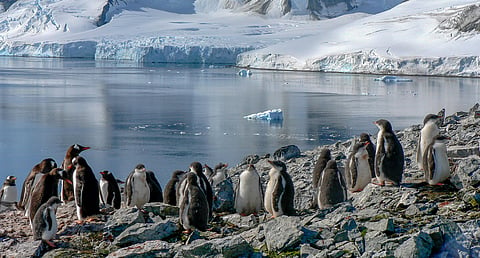

The Antarctic Peninsula is dramatically greening. The vegetation cover of this 70-km-long mountain chain has shown a 10-fold increase since 1986, according to a new study.
The vegetation cover likely increased from less than one square km (km2) in 1986 to almost 12 km2 in 2021, with an accelerated rate of change from 2016-2021, the study published in Nature Geoscience warned.
“The sensitivity of the Antarctic Peninsula’s vegetation to climate change is now clear and, under future anthropogenic warming, we could see fundamental changes to the biology and landscape of this iconic and vulnerable region,” Thomas Roland from the University of Exeter in the United Kingdom said in a statement.
The Antarctic Peninsula Ice Sheet is sensitive to climate change due to its small size and northerly location.
Antarctica has shown a warming trend over the past 60 years, with two regions—West Antarctic and Antarctic Peninsula—showing a faster change. The Antarctic Peninsula is heating up five times faster than the global average. Since 1950, the region has warmed almost 3°C.
More than 90 per cent of the glaciers have been losing mass since the 1940s.
The team used data from the National Aeronautics and Space Administration’s (NASA) Landsat satellite mission archives to study the region between 1986 and 2021.
Further analysis showed an increase in vegetation. The rate of change in vegetation cover in 2016-2021 was 0.424 km2 per year compared to the entire 35-year-long study period of 0.317 km2 per year.
Though the landscape is still dominated by snow, ice and rock, scientists are concerned about the pace of plant growth. “The tiny fraction [plant growth] has grown dramatically — showing that even this vast and isolated ‘wilderness’ is being affected by anthropogenic climate change,” Roland explained.
Vascular plants native to the Peninsula have extended their range. However, scientists are particularly concerned about moss ecosystems as they play a crucial role in changing the extent of vegetated ground cover, organic soil formation, and higher plant colonisation, the study highlighted.
Mosses, according to the study, are capable of colonising bare rock surfaces and helping future soil development to enable moss-dominated ecosystems and higher plants to take over.
“This raises the risk of non-native and invasive species arriving, possibly carried by eco-tourists, scientists or other visitors to the continent,” Olly Bartlett from the University of Hertfordshire said in a statement.
The researchers are now investigating how the recently ice-free landscapes are being colonised by plants, and how the process might continue in the future.
Temperature is likely to increase in the region. According to a 2021 study published in Climate Dynamics, temperature in the Antarctic Peninsula might increase by 0.5 to 1.5 degrees Celsius by 2044.
“We’ve been seeing overall quite big changes on the peninsula, generally getting warmer and ice shelves and glaciers discharging into the ocean,” David Bromwich, a leading author of the study and a research professor at The Ohio State University Byrd Polar and Climate Research Center and department of geography, said in a press statement.